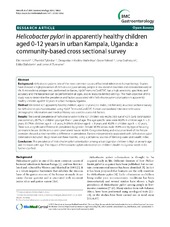| dc.contributor.author | Hestvik, Elin | en_US |
| dc.contributor.author | Tylleskär, Thorkild | en_US |
| dc.contributor.author | Kaddu-Mulindwa, Deogratias H. | en_US |
| dc.contributor.author | Ndeezi, Grace | en_US |
| dc.contributor.author | Grahnquist, Lena | en_US |
| dc.contributor.author | Olafsdottir, Edda | en_US |
| dc.contributor.author | Tumwine, James K. | en_US |
| dc.date.accessioned | 2011-04-19T09:06:50Z | |
| dc.date.available | 2011-04-19T09:06:50Z | |
| dc.date.issued | 2010-06-16 | eng |
| dc.Published | BMC Gastroenterology 10:62 | en_US |
| dc.identifier.issn | 1471-230X | |
| dc.identifier.uri | https://hdl.handle.net/1956/4677 | |
| dc.description.abstract | Background Helicobacter pylori is one of the most common causes of bacterial infection in human beings. Studies have showed a high prevalence of Helicobacter pylori among people in low-income countries and colonization early in life. A monoclonal antigen test, performed on faeces, HpSA®ImmunoCardSTAT, has a high sensitivity, specificity and accuracy and the faecal test can be performed in all ages, also in resource-limited settings. The main objective of this study was to determine the prevalence and factors associated with Helicobacter pylori colonization in apparently healthy children aged 0-12 years in urban Kampala, Uganda. Method We tested 427 apparently healthy children, age 0-12 years (211 males, 216 females), in a cross sectional survey for Helicobacter pylori colonization using HpSA ®ImmunoCardSTAT. A short standardized interview with socio-demographic information and medical history was used to assess risk factors. Results The overall prevalence of Helicobacter pylori in the 427 children was 44.3% (189 out of 427). Early colonization was common, 28.7%, in children younger than 1 year of age. The age specific rates were 46.0% in children age 1- < 3 years, 51.7% in children age 3- < 6 years, 54.8% in children age 6- < 9 years and 40.0% in children age 9- < 12 years. There was a significant difference in prevalence by gender; female 38.5% versus male 49.8% and by type of housing; permanent house 38.5% versus semi-permanent house 48.6%. Congestive living and education level of the female caretaker showed a clear trend for a difference in prevalence. Factors independently associated with Helicobacter pylori colonization included: drugs taken last three months, using a pit latrine, sources of drinking water and wealth index. Conclusion The prevalence of Helicobacter pylori colonization among urban Ugandan children is high at an early age and increases with age. The impact of Helicobacter pylori colonization on children's health in Uganda needs to be further clarified. | en_US |
| dc.language.iso | eng | eng |
| dc.publisher | BioMed Central | eng |
| dc.relation.ispartof | <a href="http://hdl.handle.net/1956/5732" target="blank">Helicobacter pylori and faecal calprotectin in apparently healthy and HIV-infected Ugandan children</a> | eng |
| dc.rights | Attribution CC BY | eng |
| dc.rights.uri | http://creativecommons.org/licenses/by/2.0 | eng |
| dc.title | Helicobacter pylori in apparently healthy children aged 0-12 years in urban Kampala, Uganda: a community-based cross sectional survey | en_US |
| dc.type | Peer reviewed | |
| dc.type | Journal article | |
| dc.description.version | publishedVersion | en_US |
| dc.rights.holder | Hestvik et al. | |
| dc.rights.holder | Copyright 2010 Hestvik et al; licensee BioMed Central Ltd. | |
| dc.identifier.doi | https://doi.org/10.1186/1471-230x-10-62 | |
| dc.identifier.cristin | 349234 | |

